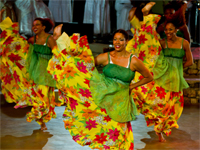An interview with Eric Galm (Ph.D.’04) by Center for the Arts Intern and Music Major Lucia Strother ’11
In anticipation of this weekend’s upcoming performances by Viver Brasil, I spoke with Eric Galm, Wesleyan graduate and professor of music and ethnomusicology at Trinity College. Galm is an expert in Brazilian music, and provided some valuable background information for Friday and Saturday’s performances.

A large portion of Brazilian music and dance has emerged from the music and dance of the African diaspora, and in Brazil, music and dance are virtually inseparable. Eric highlighted two categories of Brazilian tradition that illustrate this connection and will be represented in this weekend’s performances. Sacred music and dancing, known as candomblé, expresses African-derived religion that is still found in Brazil. There is also a lot of African-derived social dancing, generally known as batuque (the generic label applied by the Portuguese during early years in Brazil).
Later, the samba emerged through a mix of European dance styles and variants of these African dances, and is now the most popular form of music and dance in Brazil. Samba and its accompanying music was popularized in the 1930s, when dictator Getúlio Vargas made it the “official dance” of Brazil in an attempt to unify the regionally segmented nation.
Viver Brasil’s performance this weekend will extract motifs, phrases and elements from these traditional forms, and transpose them to the stage using the choreography and storytelling of modern dance. Eric previewed the program of Viver Brasil’s performance and identified that the first half will be based on sacred dance forms, while the second half will feature several types of secular dance.
In the first half, dances will invoke specific deities from Afro-Brazilian religious tradition. Eric elaborated on the way the religious storytelling is incorporated in Brazilian music and dance:
“Each of the spirits have their own set of songs and musical rhythms. For example, Xango is the god of thunder and guardian of the drums. He’s represented by the colors red and white, and dances with a double-headed hatchet or axe. There are a certain set of markers that identify him, and a strict set of songs and rhythms that make up his music.”
Therefore, anyone steeped in these religious expressions would be able to identify a particular deity and follow the storyline.
Each of the secular traditions that will be featured in the performance’s second half has its own extensive body of work with songs to choose from and adapt to the stage. One piece, In Motion, will feature capoeira, an “Afro-Brazilian martial arts dance game.” Eric mentioned that he has seen other modern dance representations of capoeira and been disappointed by the decision of those companies to eliminate the one-on-one, combat element that is so central to the art.
Audiences should expect a lot of percussion, much of it improvised. Sometimes, as in the case of the berimbau, a one-stringed percussion instrument, the percussion will actually inform the dancers’ movement. The music will also feature female vocalists and melodic instruments like flute or saxophone. I’m excited to see the variety these performances will offer, and happy to have the opportunity to experience a category of world music that is under-represented at Wesleyan.
Friday, March 25 & Saturday, March 26, 8pm
Pre-performance talk by Debra Cash in the CFA Hall at 7:15pm before the Friday performance
CFA Theater
$23 general public, $19 seniors, Wesleyan faculty/staff, non-Wesleyan students, $8 Wesleyan students


My only knowledge of Brazil is the geographical location in South America. I thought the pre talk was excellent which provided some information about the people and culture. I enjoyed the first and second half of the performance. The troup as all other dance troups performed at a level of excellence. They will perform in New York City during the month of April and it will be interesting to read the Ny Times reviews. I wonder if their reviews will be as critical as some written in the blog. I enjoyed their performance and say bravo
Thank you for the pre-concert talks. They are always helpful. I agree with some of your other bloggers that the first half was rather unexciting. Despite the talk, I missed a lot of the symbolism. It wasn’t until the second half that we really got involved, and thoroughly enjoyed the rest of the evening. It was wonderful to see the front of the auditorium filled with gyrating students.
Wonderful, wonderful, and again wonderful..See above
The absolute joy of dance, laughter, rhythm, youth,and warm desires, shared by Viver Brasil- gifted all who attended this amazing, untiring, group, with the greatest of pleasures to the eye and spirit . Debra Cash was splendid with her knowledge in introducing their beliefs/background A long winter was dispelled by their agility, beauty, in praise of life, with ancient myths and beliefs brought to us in such a unique celebration. No one could remain untouched by this superb performance. What an uplifting experience! Thank you again Wesleyan for hosting wonder.
I enjoy it .the dancers ,the drumers,the story the dancer told just wonduful
I loved the second half with the more traditional dances. I felt the first half needed more work to integrate the traditional movements with more modern dance movements. The first half, for me, lacked a spark!.
After over 30 years in the area I have just discovered your fabulous events. Went to the Sat. pre-show talk and performance of ViVer Brasil. It was extraordinary. I enjoy synchronicity and it was epitomized in that performance. Of course the show stealer in my opinion was Kahlil Cummings on djembe……i have been exploring djembe and he is now # 1 in my opinion….enjoyed him tremendously!
We thought Dance Master’s Weekend was great but the performance by Viver Brasil was every its equal. we loved it.
one of the bottom 10 performances in my years long experience as a subscriber to the dance series.